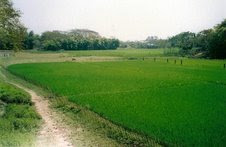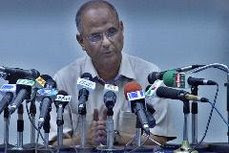
Young women in Bangladesh. A UNICEF report says that in Bangladesh alone approximately 400 women fall victim to trafficking each month. Most of them are between the ages of 12 and 16.
(Photo: Tim Graham / Getty Images)
-By Humayun Kabir Tutul
Dhaka, 3 October,2008 : Sold to a dance bar owner and forced to work in the "flesh trade", Zarina (whose name has been changed to protect her identity), a 16-year-old girl and daughter of a day labourer from Krishnapur in southeast Bangladesh, was a recent victim of human trafficking. This illegal trade has assumed dangerous proportions in recent years.
Human trafficking is an international problem; the United Nations Children's Fund (UNICEF) estimates that as many as 1.2 million children are trafficked every year. In Bangladesh alone, a UNICEF report says that approximately 400 women and children fall victim to trafficking each month. Most of them are between the ages of 12 and 16 and are forced to work in the commercial sex industry.
Zarina's story is not different from so many other girls in Bangladesh dreaming for a way out of the poverty they were born into. She, her sister and her brother-in-law were promised jobs with a monthly salary of 5,000 Bangladeshi taka ($73 US) by a family acquaintance, who urged them to follow him to Mumbai, India where "promising jobs" were waiting.
Acute poverty, illiteracy, and a lack of urban "street smarts" in small villages are some of the factors that lead to sexual exploitation of young Bangladeshi girls. Moreover, many towns are adjacent to neighbouring India, the proximity facilitating the illicit smuggling of people. These prevailing socio-economic and geographic conditions provide a fertile ground for human traffickers.
Somehow, Zarina's sister and brother-in-law were able to escape and inform Zarina's father. It took her father nine difficult months of constant effort and manoeuvring to help her return home. Bruised and tormented by what she had gone through, she faced another dilemma at home. She was shunned by her village for what had happened to her. Here, in Bangladeshi villages, tribal-like rural cultures still loom large and education about human trafficking is far from adequate.
What can be done? Local organisations in Bangladesh and other affected countries have been combining forces with regional and international partners concerned with human trafficking to address this global problem.
For example, the Bangladeshi non-profit organisation, Dhaka Ahsania Mission (DAM), initiated a new programme: The Prevention of Cross Border Trafficking in Women and Children between Bangladesh and West Bengal, India (C-BAT), in October 2005. It aims to reduce human trafficking and focuses on repatriation, reintegration and rehabilitation of the victims.
Supported by the European Commission and Irish Aid, and working closely with two Indian non-governmental organisations – the Socio Legal Aid Research and Training Centre and the Women's Interlink Foundation – efforts have been directed to building a social movement to prevent human trafficking through regular community meetings, mass dramas, seminars, and discussions, especially in Bangladesh's border areas.
The C-BAT programme helps girls in particular to learn relevant, practical skills including basic and reproductive health, nutrition, hygiene, and HIV/AIDS prevention, as well as reading, writing, critical thinking and problem-solving skills. School children learn skills to help their families change conditions of poverty, and they talk about the ploys traffickers use to get young girls to leave their villages under the false promise of respectable employment.
Capacity building of local government institutions is also a priority to ensure the success of the programme. Local administrations, as well as police and para-military personnel, are working to combat trafficking in collaboration with civil society. Public representatives, members of law enforcement authorities, local administration officials, teachers and community leaders are also being trained.
To date, over 40,000 families have been affected by C-BAT's awareness building campaigns and17 rescued victims have received shelter, psychological counselling, food and clothing, basic education and training in skills such as embroidery to make them self-reliant.
Initiating dialogue on "best practices" between countries that are facing similar crises is an important step forward. Creating workshops and trainings where governments and organisations battling human trafficking can exchange successful tips can serve as a useful tool for tackling this critical issue.
It is imperative that strong relations are developed between the people working to resolve this harmful practice both locally and internationally. Mutual co-operation and understanding is a must for reciprocal benefit.
-------------------------------------------------------------------------------------------------------------
>> Humayun Kabir Tutul works for the Dhaka Ahsania Mission in Bangladesh.
This article was written for the Common Ground News Service (CGNews).
Source: Common Ground News Service (CGNews), September 30, 2008,

